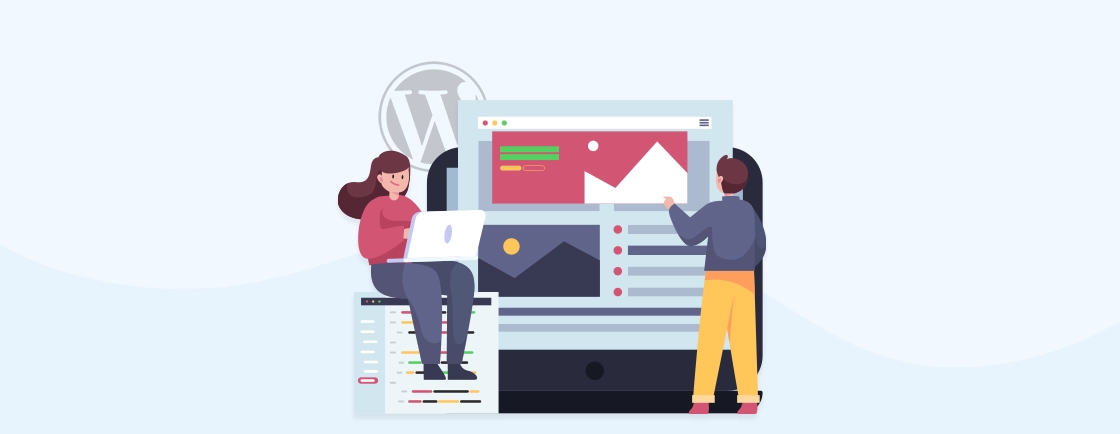Table of Contents
Sometimes, you may have come across a website that takes much more time to load than others. What is the reason behind this slow loading? Site with unoptimized media files or more dynamics that takes a longer time to load.
One of the valuable techniques you can use to make your site load faster is lazy loading. It will prioritize the required elements for loading websites, providing quicker response to users. Developers implement it using various methods like plugins, browser tools, or by just updating WordPress.
But before going further, let’s first understand what lazy loading is.
What is Lazy Loading?
Lazy loading is an optimization technique used to improve a website’s performance. It is especially useful when loading images and other media. Instead of loading the page completely, lazy loading delays the loading of non-critical resources until they are actually needed.
It saves bandwidth and resources by loading elements as users interact with them instead of preloading everything. This results in quicker page rendering and reduced server load. It makes lazy loading a crucial way to optimize sites with heavy media and dynamic content.
Benefits of Implementing Lazy Loading in WordPress
Implementing lazy loading in WordPress offers several benefits that enhance both the performance and user experience of your website. Here are the key benefits:
- Improved Page Load Time: This approach prioritizes the loading of essential resources, which accelerates the initial page load. It ensures that users can start interacting with the main content quickly. This results in improved overall performance and responsiveness of the website.
- Enhanced User Experience: With faster load times, users don’t need to wait for long, resulting in a smoother user experience. This also helps visitors stay on the site longer and engage with its content. It results in user satisfaction and a high retention rate.
- Bandwidth Savings: It benefits both you and your visitors by reducing the amount of data that needs to be downloaded. This is especially helpful for users on mobile data plans or those with limited bandwidth. Less data usage translates to lower costs for you if you’re billed based on bandwidth consumption.
- SEO Advantage: Search engines like Google consider website speed as a ranking factor in their algorithms. Faster loading times achieved through lazy loading can contribute to better SEO for your WordPress site. This can lead to increased organic traffic and visibility.
- Reduced Server Load: By distributing the loading of resources over time, lazy loading lessens the demand on the server. This reduction in peak load improves the server’s ability to handle high traffic volumes. This enhances overall site stability and performance. You can also look into WordPress object cache to manage resource distribution.
- Ease of Implementation: Various WordPress plugins simplify lazy loading implementation, requiring less technical knowledge. Plus, you can implement custom lazy loading by using JavaScript and browser APIs, which offers more flexibility. This option makes lazy loading accessible to a wide range of users.
- Boosts Mobile Performance: Large files often impact website loading times, especially for mobile devices with slower connections. Lazy loading can improve the mobile user experience by prioritizing the essential content first.
- Contributes to Better Core Web Vitals: They are a set of metrics used by Google to measure and check website performance. This approach can improve Core Web Vitals metrics, such as Largest Contentful Paint (LCP) and First Contentful Paint (FCP).
Lazy loading in WordPress speeds up page load times, improves user experience, and reduces bandwidth use. It also boosts SEO rankings and site performance, especially on mobile. Want to make your WordPress site faster and more SEO-friendly, consider working with a WordPress development company can help you implement lazy loading and other performance optimizations. Let’s build a faster site together.
How to Implement WordPress Lazy Load?
WordPress versions 5.4 and higher include a built-in lazy loading feature for images by default. So if you want to implement this feature with ease, just upgrade your website to WordPress 5.4 and higher.
Method 1: Using a WordPress Plugin
For more control and functionality, installing a lazy load plugin is the way to go. Here’s a general process:
Step 1: Choose a plugin from the popular options like WP Rocket, a3 Lazy Load, and Autoptimize. Each offers different features, so explore them to find the best fit for your needs.
Step 2: Go to the WordPress dashboard → Plugins → Add New. Search for your chosen plugin, install it, and activate it.
Step 3: Now configure the plugin; most plugins offer settings to customize lazy loading. You can typically define:
- Elements to lazy load: Choose which elements to lazy load (images, videos, iframes).
- Exclusions: Specify pages or images you want to exclude from lazy loading.
- Placeholder Images: Set placeholder images to appear before the actual image loads.
Step 4: Use browser developer tools or performance optimizing tools like Google PageSpeed Insights to verify lazy loading. As a best practice, ensure that images and other media elements load as they come into view.
A plugin gives you more control over lazy loading, allowing you to lazy load, exclude specific content, and configure settings.
Method 2: Using Browser to Enable Native Lazy Loading
Modern web browsers like Chrome, Firefox, and Opera have built-in support for lazy image loading. However, this relies on the website itself, including the necessary code (loading=”lazy” attribute in the image tag).
Step 1: Look for the loading=”lazy” attribute in your website’s image tags. If it’s not present, this method won’t work.
Step 2: While there’s no universal setting, some browsers might have options related to lazy loading in their developer settings. However, this is not a recommended approach for most users as it relies on site code having the loading=”lazy” attribute.
By adding the loading=”lazy” attribute directly to your HTML tags, you enabled native lazy loading. It is a method that leverages browser capabilities to improve page load times and resource efficiency without relying on plugins.
You can choose the right method to implement lazy loading based on your expertise and requirements. If you want more options, then using a WordPress plugin is the recommended method.
Pros and Cons of Implementing WordPress Lazy Loading
Lazy loading offers significant benefits for WordPress websites, but it’s not without its drawbacks. Here’s a breakdown of the pros and cons to help you decide if it’s the right approach for your site:
Pros
- Faster Loading Times: This is the biggest benefit. By only loading content as users scroll, the initial page load is quicker, keeping visitors engaged.
- Reduced Bandwidth Usage: This can save on hosting costs, especially for bandwidth-heavy sites with lots of images.
- Improved User Experience: Faster loading times lead to happier users, who are more likely to stay on your site and convert.
- Improved SEO: Google prioritizes fast-loading sites in search results, so lazy loading can give you a ranking boost.
- Boosted Mobile Performance: Mobile users often have slower connections, so lazy loading is even more crucial for a smooth mobile experience.
- Contributes to Better Core Web Vitals: Core Web Vitals are metrics that measure user experience, including Largest Contentful Paint (LCP) which benefits from lazy loading.
Cons
- Potential for Layout Shifts: As images load later, they can cause the page layout to jump around. This can be jarring for users. Careful implementation with proper placeholder dimensions can minimize this.
- Compatibility Issues: Some themes or plugins may not play well with lazy loading, causing unexpected behavior. Testing is important.
- Reduced Ad Revenue (for ad-reliant sites): If ads are lazy loaded, they may not appear until users scroll down, potentially reducing ad impressions.
- JavaScript Reliance: Lazy loading often relies on JavaScript. If users have JavaScript disabled, images may not load at all. There are workarounds for this, but it’s something to consider.
- Limited Control with Built-in Lazy Loading: WordPress’ built-in lazy loading (since version 5.4) offers less control than plugin options. Plugins can give you more flexibility in what content to lazy load.
Implementing lazy loading has its pros, but if you don’t update and maintain WordPress site well, it could negatively impact your site.
Conclusion
Implementing lazy loading is a simple yet effective technique to optimize website performance. Here are three methods that you can use as per your requirements:
- If you’re using WordPress 5.4 or higher and only need basic lazy loading for images, upgrading is the simplest option.
- For more control, customization, and lazy loading of other media types, a plugin is the way to go.
- Using browser-level lazy loading, you can directly add loading=”lazy” code to an HTML file.
By effectively implementing lazy loading you can enhance the page load speed and also the SEO. To get help building a site that is robust, well designed and optimized, hire WordPress developers today.
FAQs on Implementing WordPress Lazy Loading
Can I adjust the Lazy Load settings on my WordPress site?
Yes, most Lazy Load plugins offer customizable settings that you can use to adjust the behavior of your site. For example, you can choose which elements to delay the loading of or set when the elements should start loading.
What Elements Can Be Lazy Loaded?
Images are the most common element that is lazy loaded. But you can also extend it to other media like videos, iframes, and even background images on CSS elements.
How does lazy loading affect SEO?
Lazy loading can improve SEO by reducing page load times and enhancing user experience. However, improper implementation might result in important content not being indexed by search engines.
Create with WordPress CMS
Build flexible and scalable websites using WordPress's powerful content management system.





